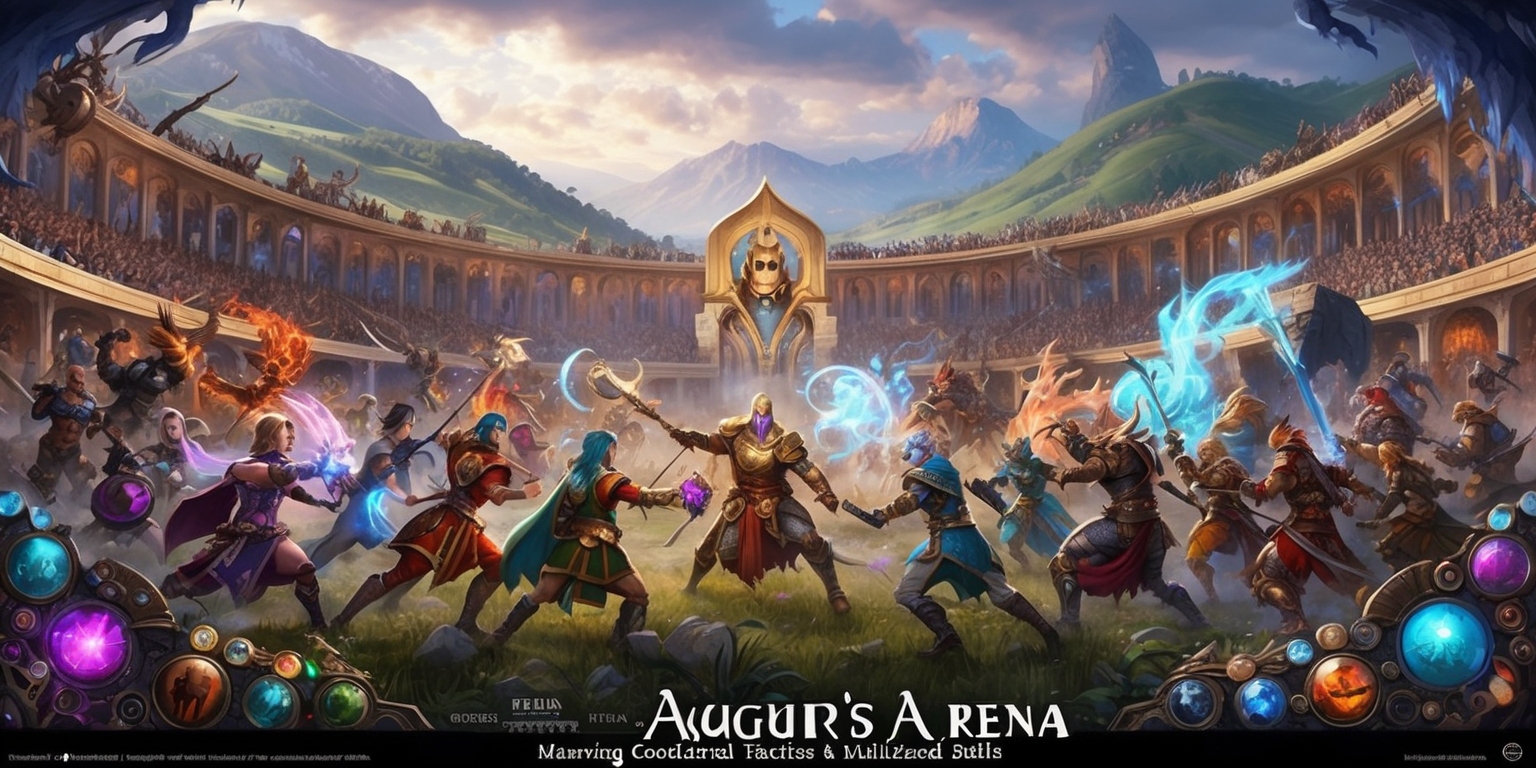 2025-07-24 05:14:01
2025-07-24 05:14:01 Augur's Arena: Mastering Coordinated Tactics in a Multifaceted Battle
The immersive experience of facing a high-stakes challenge in Elden Ring is captured vividly in the encounter with the enigmatic Nightreign boss, Augur. Unlike the conventional one-on-one duels typical of the game, this confrontation mirrors the strategic depth and coordination found in large-scale raid scenarios. Within the dynamic arena, players must balance precise movements, well-timed ultimate skills, and a careful selection of classes to overcome an opponent who dominates the field with uncanny control. Every detail in this encounter—from the boss’s multi-stage attack patterns to the subtle creation of hazards—adds to an intricate dance of strategy and reaction. The battle compels each participant to synchronize their efforts, harnessing both individual and collective strengths in pursuit of victory.
Unraveling the Dynamic Battlefield
The arena where Augur commands its power is more than a mere stage; it functions as an interactive battlefield with strategic elements that push players to adapt continuously. The boss demonstrates minimal direct aggression, yet its command over space is profound. By invoking diverse hazards and summoning dangerous entities, Augur transforms the terrain into a labyrinth of challenges. Precise positioning and calculated movements become essential, as safe zones shift between phases of the encounter. Advanced players quickly recognize that the environment itself becomes an adversary. The spatial layout demands a balance of distance and proximity, prompting groups to maintain dispersion while coordinating attacks. Every step taken in the arena is laden with potential peril, requiring not only agility but also a keen sense for forecasting the boss’s next maneuver.
Dissecting the Boss’s Multifaceted Attack Patterns
Augur deploys a surprisingly limited yet varied arsenal of offensive moves that combine into a seamless barrage. The battle unfolds in phases, and during the initial phase, the boss uses a series of meticulously timed strikes. Among these, there are attacks that summon jellyfish-like entities which roam the battlefield, a set of sudden tentacle eruptions from the ground, and a swift, wave-like motion produced by the extension of its massive body. As the encounter escalates, a more aggressive posture emerges where the boss repeatedly unleashes powerful wave attacks, introduces additional, more volatile hazards like an exploding egg, and even rotates itself to generate spiral waves of energy. Understanding the distinct phases and permutations within each move is critical for any team intent on mastering this complex encounter.
Mastering Evasive Maneuvers Under Pressure
Survival in the midst of Augur’s relentless assaults demands impeccable timing and acute spatial awareness. Players learn quickly that adopting dynamic evasion patterns is paramount when confronted by the boss’s array of rapid and, at times, overlapping moves. This is particularly true with the fast-moving wave attacks where every moment counts. The strategy involves studying each incoming threat closely and opting for side-steps or forward dashes at the exact moment required. Quick reflexes often mean the difference between narrowly avoiding a hazardous impact or succumbing to a delayed reaction. The intricacy lies in the fact that each dodge must be planned with a clear understanding of how the surrounding arena alters with each attack, forcing players to constantly reassess their positioning in order to safely navigate the chaos of the battlefield.
Examining the Menace of Summoned Entities

Augur’s power is amplified by its ability to conjure unsettling, jellyfish-like clusters. These ephemeral entities drift across the arena with a silent menace, posing a significant threat if left unchallenged. Once spawned, they gradually move closer to the players until reaching a critical point where they unleash a damaging burst of energy. The persistent presence of these creatures compels the player group to maintain constant motion. It is not merely enough to fixate attention on the boss; the summoned hazards themselves require rapid responses and coordinated offensive actions. Managing these threats adds a layer of tactical complexity to the encounter. The interplay between eliminating summoned hazards in a timely manner and delivering effective counterattacks against Augur creates a rhythm of offense and defense that tests both individual reflexes and group coordination in equal measure.
Confronting the Disturbing Sleep Wave
Among Augur’s diverse set of abilities, the sleep wave represents one of the most disruptive challenges faced by adventurers. As the boss lingers in a stationary state, it envelops the entire arena in an insidious buildup of sleep energy. This phenomenon leaves the team at great risk, as prolonged exposure can overwhelm individual stamina and leave characters incapacitated. In this critical moment, the focus shifts from careful evasion to rapid offensive measures. The key to survival lies in launching an immediate and concentrated assault to disrupt the ongoing process. The buildup is relentless, and any lapse in coordination can result in a wave of pooling sleep energy that leaves everyone vulnerable. Facing such a threat underlines how even phases of relative stillness can rapidly evolve into a decisive juncture demanding unified, swift action.
Decoding the Combined Threat of Tentacles and Fluid Waves
A further layer of tactical intensity is introduced when Augur summons massive tentacles that emerge from the ground, intertwining with its fluid, wave-like assaults. This combination requires careful and swift adjustments from the players. The tentacles, when raised, serve to restrict movement and impose damage if a character is caught in their forceful trajectory. Their emergence demands that players move laterally or strategically reposition to avoid severe hits. At the same time, the fluid waves—generated by the boss’s extended body—further compound the challenge, as they propagate rapidly across the arena. The simultaneous presence of both environmental hazards forces the team to manage dual defensive priorities. Practicing simultaneous evasion while coordinating retaliatory strikes against vulnerabilities offers a glimpse into the nuanced strategy required for emerging victorious in this multifaceted battle.
Evaluating the Role of Varied Combat Styles
The confrontation with Augur brings distinct advantages and limitations to each combat style present within the team. For those who favor close-ranged engagements, the battle does not favor their style due to the constant movement and distance enforced by Augur’s tactics. Characters built for ranged engagements or those equipped with powerful long-range weaponry tend to excel, as they can safely land critical strikes from afar. Meanwhile, some characters with abilities that augment speed or provide swift repositioning can harness these traits to navigate through the challenges. The nuances of each class come into play, where calibration of offensive force must be balanced with the need for agile movements across the battlefield. In this crucible of strategy and skill, varying combat styles provide unique contributions to offset the boss’s dominating presence.
Harnessing the Power of Environmental Weaknesses
One of the more strategic revelations in battling Augur is the vulnerability rooted in its elemental affinities. Specifically, Augur exhibits a heightened susceptibility to lightning-based attacks—a detail prominently noted prior to embarking on this arduous expedition. The acknowledgment of this weakness transforms the engagement into a more calculated affair as players then position themselves to exploit this flaw. Beyond elemental advantages, certain weapon enhancements and status effects may offer additional leverage, although the primary focus remains on channeling relentless offensive power. The emphasis on natural vulnerabilities creates an undercurrent of both risk and reward, where judicious application of potent weapons can tip the scales. In this respect, a thorough understanding of the boss’s inherent resistances and susceptibilities is fundamental for any group determined to dominate the encounter.
Synchronizing Efforts Within a Diverse Ensemble
Coordination among team members is not merely a recommended strategy but a fundamental requirement in the face of Augur's overwhelming battlefield control. The challenge demands that players assign roles based on individual strengths and the unique mechanics of the boss encounter. Forming a balanced ensemble can involve combinations such as multiple long-range specialists paired with classes that are adept at disrupting environmental hazards. The interplay of different class abilities, such as rapid repositioning and area denial, fosters an environment where quick responsiveness is rewarded with tactical advantage. Each player’s contribution must align seamlessly with the broader strategy, as failure by any one member can quickly escalate the threat level. This synergy underscores how critical coordinated group dynamics become in turning a treacherous encounter into an opportunity for shared success.
Navigating Through the Complexity of Timed Interventions
An essential aspect of the challenge lies in the precision of timed interventions. When Augur deploys its signature tactics—ranging from the explosive sleep egg to vigorous spinning wave maneuvers—each moment is charged with potential consequences. Timing becomes a commodity of high value, with players needing to disrupt the boss’s sequences at the exact moment each move reaches its critical stage. In particular, the exploding sleep egg becomes a focal point for rapid counterattacks; any delay can result in a chain reaction that leaves the party vulnerable. This battleground of incidents demands that each participant possesses a honed sense of situational awareness. Success is measured not merely by raw damage output but by the ability to swiftly shift strategies as the tide of battle continually evolves.
Crafting a Synergistic Combat Formation
The final aspects of this intricate encounter revolve around the formation of strategies that weave together the strengths of disparate combat classes into a unified force. With Augur deliberately maintaining distance from melee range, emphasis naturally shifts toward team members who can engage effectively from afar. Groups typically constitute combinations such as three long-range specialists, or a blend of these with classes that provide supplementary support through rapid disruption of the boss’s summoned hazards. The candidate from the magic-using crew, when optimized, can further enhance the team's effectiveness by applying area-based effects and additional elemental damage. While each role offers unique contributions to dealing damage and controlling the flow of battle, their coordinated actions are paramount in neutralizing Augur’s diverse and shifting offensive repertoire.




Leave a comment
Your comment is awaiting moderation. We save your draft here
0 Comments